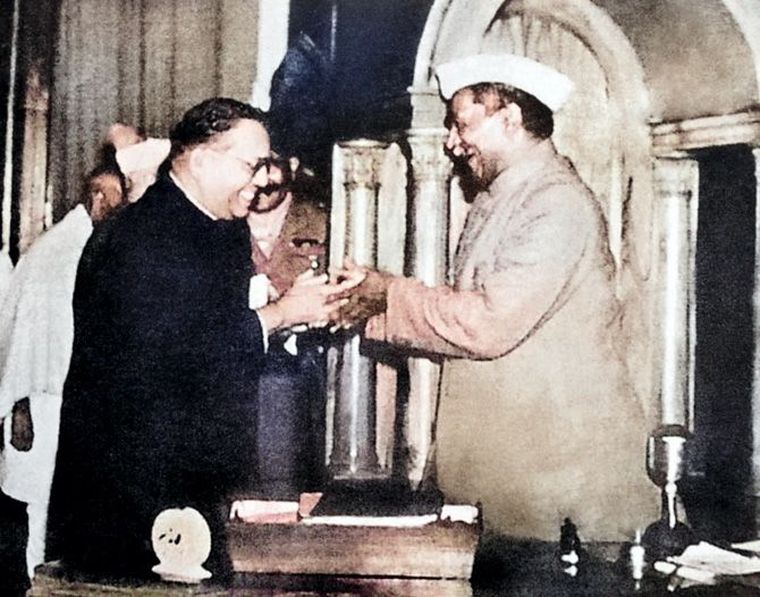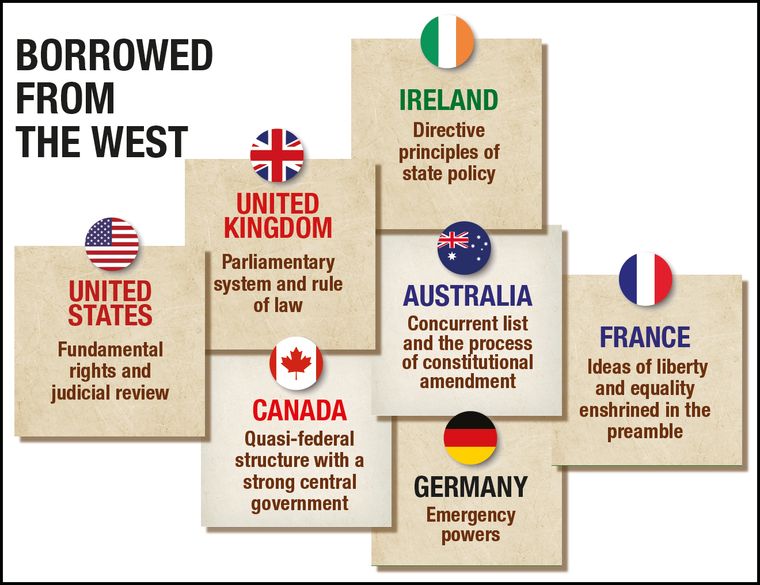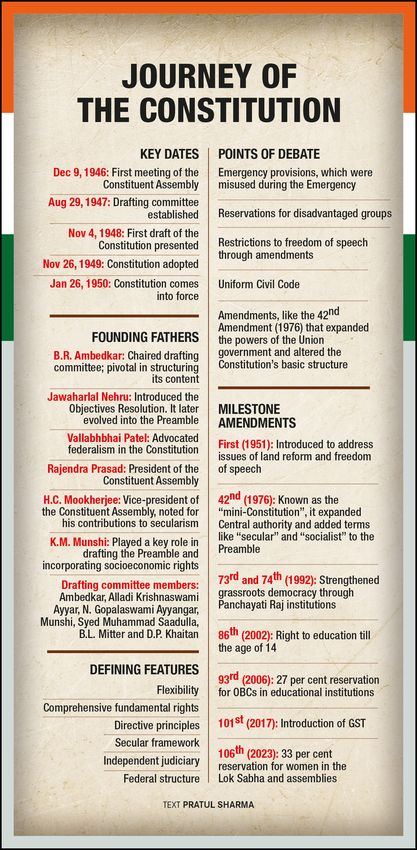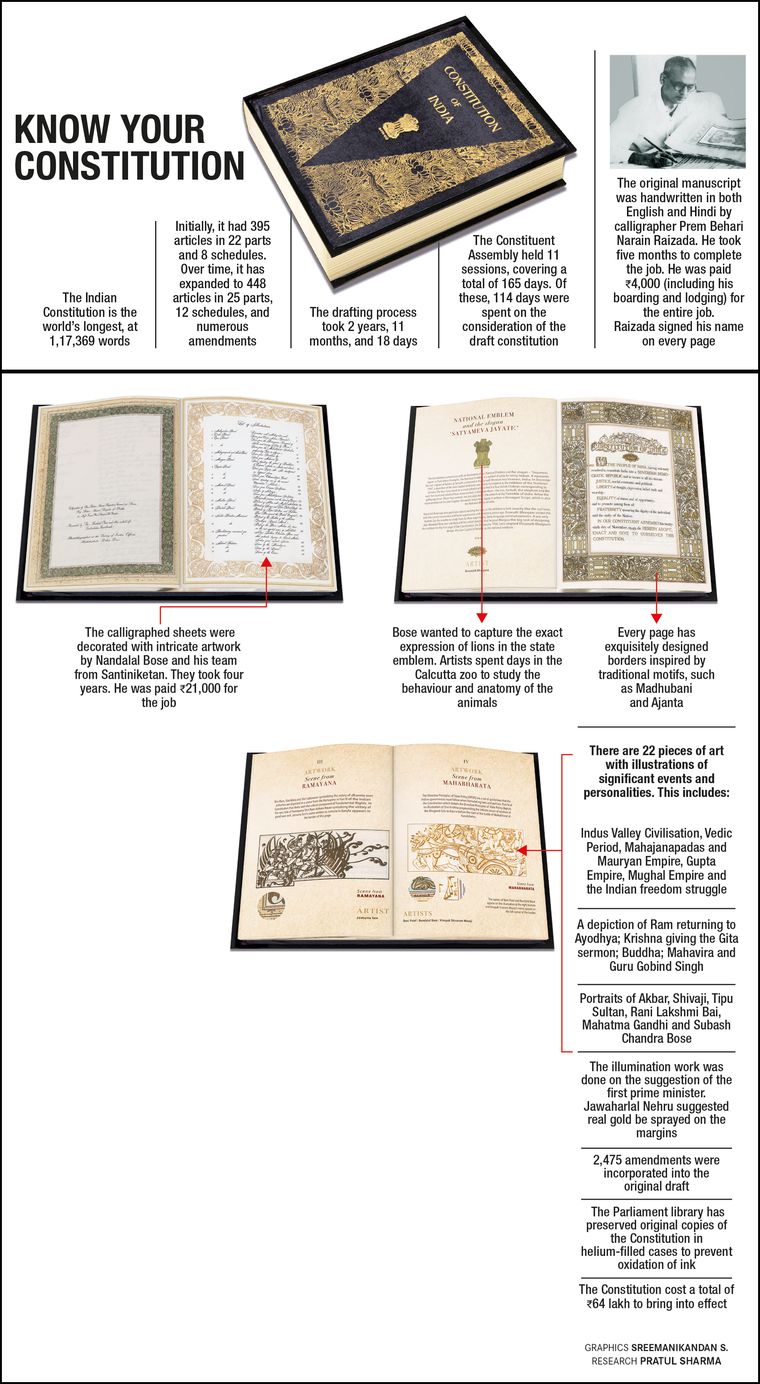The last winter session of Parliament marked 75 years of the Indian Constitution with a debate in both the houses. One might have hoped that the discussions would echo the enthusiasm of the Constituent Assembly when it began its nearly three-year effort to draft the constitution of a new nation in 1946. Instead, the session saw a blame-game between the treasury and opposition benches, with both sides accusing the other of betraying the vision of the founding fathers, particularly Dr B.R. Ambedkar. While each reaffirmed their faith in the Constitution, the discourse left listeners none the wiser.
It was on December 9, 1946, that 205 of the 299 members of the Constituent Assembly travelled from different parts of the country for the historic responsibility. The first meeting took place at 11am in the Constitution Hall. The assembly was formed in the backdrop of 62 of around 500 princely states having already framed their constitution, and 286 others in the process of doing the same.
The formal drafting process began on December 13 during the assembly’s fifth sitting, with Jawaharlal Nehru presenting the ‘objectivesresolution’. Constitutional expert Subhash Kashyap termed them as “the horoscope of the sovereign democratic republic”. “We are functioning on a world stage and the eyes of the world are upon us and the eyes of our entire past are upon us,” Nehru told the assembly. “Our past is witness to what we are doing here and though the future is still unborn, the future, too, somehow looks at us.”
The objectives resolution eventually evolved into the Preamble after threadbare discussions. The assembly rejected a suggestion calling for the usage of the word ‘God’ in the Preamble. ‘Socialist’ and ‘secular’ were added to the Preamble later, after the 42nd amendment in 1976.
Exactly 78 years since Nehru’s speech, his great-granddaughter, Priyanka Gandhi, delivered her maiden speech during the debate on Constitution in the Lok Sabha last December 13. She accused the ruling party of dismantling the Constitution’s protective framework and attempting to alter its essence. Before her, Defence Minister Rajnath Singh had criticised the Congress for subverting the Constitution in pursuit of power. The subsequent discussions in the Rajya Sabha mirrored the Lok Sabha debate, with members on both sides vowing to uphold the Constitution while accusing the other of undermining it.
The fact that the Constitution has endured 75 turbulent years―adaptable enough to be amended yet resilient enough to retain its essence―speaks volumes about its strength. Just like India, which belied the naysayers who said the country could self-destruct. The statute book’s true value becomes most evident when the freedoms it guarantees are threatened as it happened during the Emergency. Otherwise, for a common man, it remains a largely faceless document, the unsung backbone of the republic.
The recent parliamentary debate and the use of a copy of the Constitution as a political prop during the recent Lok Sabha elections showed that debates around it find resonance, particularly among the marginalised sections of society who have been empowered by it. The enduring image of the chairman of the drafting committee―Ambedkar―holding it in his hands instils faith in millions. The rediscovery of Ambedkar in popular imagination, more than seven decades after his death, and even by political parties, activists and the civil society, highlights his brilliance and scholarship.
In his final speech at the adoption of the Constitution, Ambedkar said, “On 26th January 1950, we are going to enter into a life of contradictions. In politics, we will have equality, and in social and economic life, we will have inequality. In politics, we will be recognising the principle of one man-one vote and one vote-one value. In our social and economic life, we shall, by reason of our social and economic structure, continue to deny the principle of one man-one value.”
Seventy five years later, the words still resonate.
Indian Constitution is a ‘living document’, blending tradition with modernity. To provide legal and social framework for the newly born nation, emerging from the shadows of a horrific partition and Mahatma Gandhi’s assassination, the Constitution framers looked at the best models from major countries to embody the principles of justice, equality, liberty and fraternity, while addressing the challenges of a vast, diverse and evolving nation.
“We wanted the music of veena or sitar, but here we have the music of an English band,” said Kengal Hanumanthaiah, a Constituent Assembly member, criticising the new document. Another member, Naziruddin Ahmad, had termed the drafting committee as the “drifting committee” for taking a long time. Ambedkar responded to all charges with humour and statesmanship, highlighting the robustness of the debate that went into its making.
Ambedkar acknowledged the borrowing from the west, saying, “... very little of it can claim originality. One likes to ask whether there can be anything new in a Constitution framed at this hour in the history of the world....”
US historian Granville Austin, in his masterly analysis, The Indian Constitution: Cornerstone of a Nation, said, “The theme of social revolution runs throughout the proceedings and documents of the Assembly. It provided the basis for the decisions to adopt parliamentary government and direct elections, the fundamental rights and the directive principles of state policy, and even many aspects of the executive, legislative and judicial provisions of the Constitution.”
Since its adoption in 1950, there have been many challenges to the Constitution, particularly over the interpretation of its various statues and provisions. But what the Supreme Court articulated in its 1973 Kesavananda Bharati judgment stressing on the ‘basic structure doctrine’ has come to be accepted as a valid and a strong core. The 7:6 court judgment argued that certain fundamental features of the Constitution cannot be altered or destroyed through amendments by Parliament, thus preventing its potential abuse by the executive. But it has also been often criticised, as it allows the judiciary power over the elected executive. Kashyap, however, argues that no majority judgment is available laying down all the features of the Constitution that may be considered ‘basic’. The courts interpret based on the individual cases under its scrutiny.
Among the current debates on the interpretations of the Constitutional law that generated enough heat was over the abrogation of Article 370―bringing Jammu and Kashmir under the same framework as rest of India; the introduction of the Citizenship Amendment Act (CAA), which allowed six persecuted minorities barring Muslims from neighbouring countries to get Indian citizenship; and the NDA government’s push for the introduction of the Uniform Civil Code (UCC), which was proposed in the directive principles for implementation at the opportune time. Those opposing the policies of the current government have also been against the introduction of ‘one nation, one election’ system of simultaneous polls, saying it goes against the spirit of federalism.
While the apex court had upheld the abrogation of Article 370, it rejected a PIL challenging the move to introduce UCC. The court had batted for the introduction of UCC in its multiple judgments for bringing “uniformity and promoting national integration”. The court is currently hearing the CAA case, while refusing to stay the implementation of the rules under the act.
The 12th Law Commission of India had recommended against implementing UCC, citing lack of consensus, but the BJP-led government has been pushing for its implementation, particularly in the party-ruled states. Uttarakhand, which has close to 97 per cent Hindu population, has already enacted a law on it.
Speaking during the debate on Constitution, Prime Minister Narendra Modi said, “Keeping in mind the spirit of the Constitution and the sentiments of the Constitution’s framers, we are fully committed and working with all our strength towards establishing a secular civil code.” He also supported the CAA, saying the government proudly upholds it as it was in sync with Mahatma Gandhi’s vision and in the spirit of the Constitution.
Also Read
- PM Modi’s I-Day speech: When THE WEEK featured Hansa Mehta, Dakshayani Velayudhan, other women Constitution makers
- How British laws guided the creation of the Indian Constitution
- Republic Day special: President Droupadi Murmu's tribute to the founding mothers of the Constitution
- Meet the 15 extraordinary women who laid the foundation for a democratic and inclusive India
- Time to formally incorporate Basic Structure Doctrine into constitutional framework: Manish Tewari
- Constitution reminds us that national oneness comes through addressing inequalities: Manoj Kumar Jha
If the Emergency of 1975 shall remain a testament to the challenges that threaten the constitutional provision, the use of Article 356 to remove state governments has been a bane. There have been more than 126 attempts to dismiss state governments by the Central government.
Ambedkar’s prescient words act as a reminder for the people: “However good a Constitution may be, it is sure to turn out bad because those who are called to work it happen to be a bad lot. However bad a Constitution may be, it may turn out to be good if those who are called to work it happen to be a good lot.”
Though much of the Indian constitution was shaped by the west, as constitutional expert Madhav Khosla said, in matters ranging from the Election Commission to conditional social rights to secularism without an establishment clause to the basic structure doctrine, India’s constitutional landscape finds no foreign equivalent.
The experience of the Indian democracy, however turbulent, has its roots in the bold move by the founding members in assigning ‘one man, one vote’, which has empowered people to keep the balance every election.







